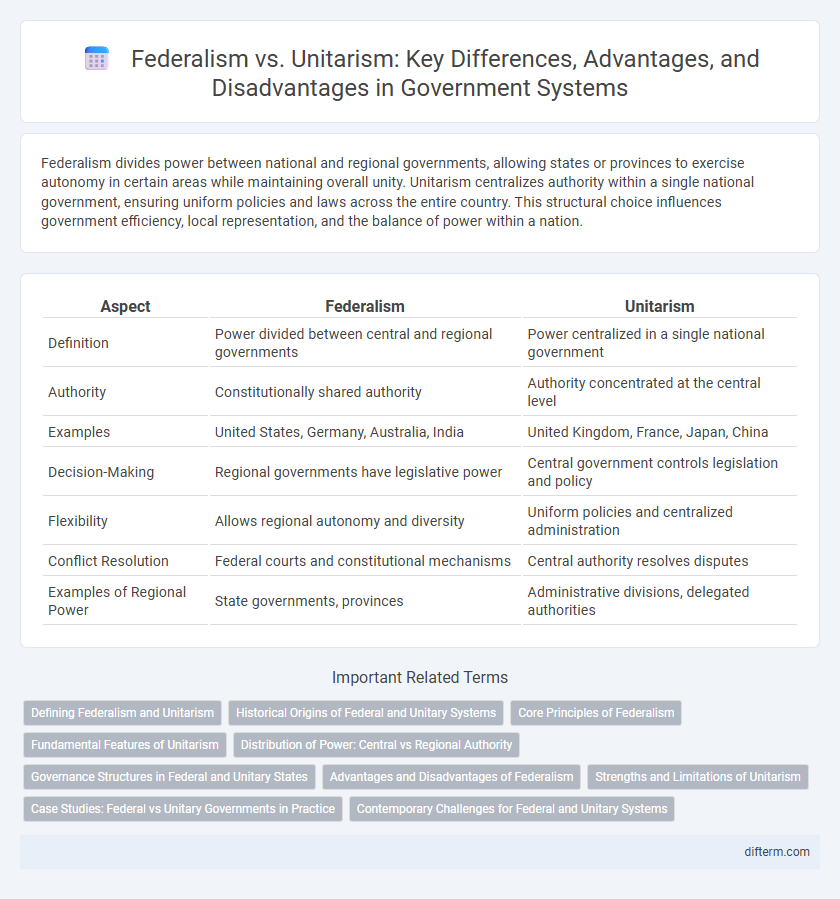Federalism divides power between national and regional governments, allowing states or provinces to exercise autonomy in certain areas while maintaining overall unity. Unitarism centralizes authority within a single national government, ensuring uniform policies and laws across the entire country. This structural choice influences government efficiency, local representation, and the balance of power within a nation.
Table of Comparison
| Aspect | Federalism | Unitarism |
|---|---|---|
| Definition | Power divided between central and regional governments | Power centralized in a single national government |
| Authority | Constitutionally shared authority | Authority concentrated at the central level |
| Examples | United States, Germany, Australia, India | United Kingdom, France, Japan, China |
| Decision-Making | Regional governments have legislative power | Central government controls legislation and policy |
| Flexibility | Allows regional autonomy and diversity | Uniform policies and centralized administration |
| Conflict Resolution | Federal courts and constitutional mechanisms | Central authority resolves disputes |
| Examples of Regional Power | State governments, provinces | Administrative divisions, delegated authorities |
Defining Federalism and Unitarism
Federalism is a system of government where power is constitutionally divided between a central authority and constituent political units, allowing regional governments to exercise independent authority in certain matters. Unitarism, by contrast, centralizes political power within a single national government, with administrative divisions exercising powers as delegated and subject to the central government's control. The distinction lies in the distribution of sovereignty, with federalism promoting shared governance and unitarism emphasizing centralized control.
Historical Origins of Federal and Unitary Systems
Federal systems historically emerged from agreements or compromises among multiple states or regions seeking to retain local autonomy while forming a unified government, as seen in the formation of the United States Constitution. Unitary systems trace their origins to centralized monarchies and empires, where sovereign power was consolidated under a single national authority to ensure uniform governance. These foundational differences reflect contrasting approaches to sovereignty, with federalism emphasizing shared power and unitarism focusing on centralized control.
Core Principles of Federalism
Federalism is based on the division of powers between a central authority and constituent political units, allowing regional governments to exercise autonomy in certain policy areas. This system emphasizes the protection of local interests, the sharing of sovereignty, and the establishment of a constitution that delineates the scope and limits of governmental authority at each level. Federalism promotes a balance between unity and diversity by enabling multiple levels of government to coexist while maintaining distinct responsibilities.
Fundamental Features of Unitarism
Unitarism centralizes political power within a single, sovereign government, ensuring uniform policies and governance across all regions. This system features a centralized administrative structure where local governments operate under the authority and direction of the central government. Unitarism promotes national unity and administrative efficiency by reducing regional autonomy and preventing the division of sovereignty.
Distribution of Power: Central vs Regional Authority
Federalism allocates power between central and regional authorities, granting states or provinces significant autonomy to enact laws, manage budgets, and govern local affairs independently. Unitarism centralizes authority within a single national government, limiting regional powers to those delegated and revocable by the central government. The distribution of power in federal systems promotes regional diversity and local governance, while unitary systems emphasize uniform policy implementation and national cohesion.
Governance Structures in Federal and Unitary States
Federal governance structures distribute power between central and regional governments, allowing autonomous legislative, executive, and fiscal authority within constituent units, which fosters local decision-making and regional diversity. In contrast, unitary governance centralizes authority in a single national government, with subnational units operating mainly as administrative arms with limited or delegated powers. This structural difference impacts policy implementation, resource allocation, and political accountability across federal and unitary states.
Advantages and Disadvantages of Federalism
Federalism allows for regional autonomy, accommodating diverse populations and enabling tailored policy-making that reflects local needs, which enhances democratic participation and reduces the risk of authoritarianism. However, it can lead to inconsistencies in laws and regulations across states, complicate coordination in national policymaking, and potentially foster regional inequalities and intergovernmental conflicts. The balance between shared sovereignty and localized governance presents both opportunities for innovation and challenges in maintaining national unity and efficiency.
Strengths and Limitations of Unitarism
Unitarism centralizes political authority, ensuring uniform policy implementation and streamlined decision-making processes across the entire nation, which enhances national unity and administrative efficiency. Its limitations include reduced regional autonomy, which may lead to dissatisfaction among diverse or geographically distant groups and potential neglect of local needs. This system often struggles with adaptability in large, culturally heterogeneous countries, limiting its effectiveness in addressing localized issues.
Case Studies: Federal vs Unitary Governments in Practice
Federalism in governments like the United States and Germany allows for regional autonomy, enabling states or provinces to create laws tailored to local needs while maintaining a central authority for national matters. Unitarism, as demonstrated by France and Japan, concentrates power within a central government, resulting in uniform policies and streamlined administration across the entire country. Case studies reveal that federal systems often foster diversity and accommodate regional differences, whereas unitary systems excel in policy consistency and national integration.
Contemporary Challenges for Federal and Unitary Systems
Contemporary challenges for federal systems include managing intergovernmental disputes and ensuring equitable resource distribution across diverse regions with varying socio-economic needs. Unitary systems face difficulties in addressing regional autonomy demands and preventing centralized power from stifling local governance innovation. Both frameworks must adapt to globalization and digital governance advancements, balancing efficiency with democratic representation.
Federalism vs Unitarism Infographic

 difterm.com
difterm.com